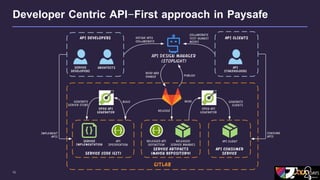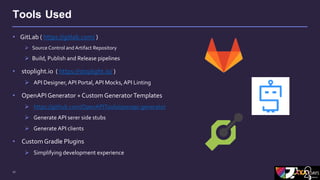Practical Application of API-First in microservices development
- 1. Practical application of API-First approach in microservice development 22.12.2020 Chavdar Baykov SolutionArchitect (Digital Wallets, Paysafe Group) [email protected]
- 2. • Started programming, with BASIC, when Apple II was a big thing, long, long time ago… • Spent few years doing competitive programming - algorithms and such… • Spent 19 years developing and architecting different solutions in SAP Java, Web Services, SOAP, JAXB, SAP HANA, SAP Cloud Platform • Joined Paysafe DigitalWallets July 2019 as SolutionArchitect • Interests include: Pragmatic and Agile Architecture Development Productivity Clean Code and Clean Architecture Tech gadgets… About Me 2
- 3. Importance of APIs ? 3
- 4. 4 Monolithic vs Microservices Architecture
- 5. 5 • Tightly coupled Statically linked dependency • Very low latency • “Unlimited” bandwidth • High data integrity • Always available • Single deploy • Scale vertically • Inside trust boundary • Loosely coupled • High latency and overhead • Limited bandwidth • Various data conversions applied Encodings,XML, JSON, … • Outages are possible • Independently deployed • Horizontally scalable • Outside trust boundary Local Calls vs Remote (RESTful) API Calls
- 6. 6 • Poor development productivity Poorly documented Hard to use and understand Inconsistent interaction patterns • Poor performance Ineffective communication patterns or data structures • Low reliability Incompatible changes are often required or happening Interactions end up in undetermined state Data Integrity Issues • High operation cost Impact of Poor (RESTful) API Design
- 7. 7 • Use case centric • Intuitive, clear and consistent • Stable and self contained • Well documented Provide examples and Mock/Test Endpoints • Formally defined using API definition language Open API 3.0 or 2.0 specification • Follow REST best practices Qualities of Good RESTful APIs
- 8. 8 How do we build APIs ?
- 9. 9 Code-First Approach to building APIs
- 10. 10 Characteristic to Code-First Approach • Preferred for Speed of Delivery • APIs are byproduct of Implementation • API Specification is inferred from the implementation • No API Contract established upfront • Long feedback cycle on API Quality • Data integrity and compatibility issues happen often • Exposing the implementation Data Model has long term impact
- 11. 11 Treat APIs as First-Class Citizens 1. Brainstorm 2. Establish stakeholders 3. DesignAPI Contract 4. Create Style Guide 5. Implement API Governance 6. Automate Processes 7. Track and ManageAPIs 8. Provide API Portal for Developers API-First approach to building APIs
- 12. 12 Benefits of API-First • Early feedback on API quality • Reduces rework • Developers can work in parallel • Ensures good development experience • Reduces middleware use and complexity
- 13. 13 • Higher learning curve for developers Open API Specification and JSON Schema API DesignTools API Design Best Practices • Requires initial alignment with stakeholders • No API Portal orAPI Design tool access or streamlined development tooling • High pressure to deliver “something” Challenges adopting API-First
- 14. 14 Developer Centric Approach to API-First • Keep API-Specification close to the implementation and developers • Stored in Git and all changes are tracked • Allow various API DesignTools usage • Web or Desktop API Design tools (on top of Git) • IntegrateAPI Lifecycle into Software Development and Release Process • API Publication on API Portal during central build • Release of associated APIArtifacts, along with service implementation • Provide Developer friendly environment for API implementation and consumption • Server-side stub or Client generation as part of the build process
- 15. 15 Developer Centric API-First approach in Paysafe
- 16. 16 DEMO – Calculator Service 1. Define Calculator API 2. Prototype and PublishAPI Candidate to Stakeholders 3. ImplementCalculator API 4. Release API 5. Consume API
- 17. 17 Tools Used • GitLab ( https://gitlab.com/ ) Source Control and Artifact Repository Build, Publish and Release pipelines • stoplight.io ( https://stoplight.io/ ) API Designer,API Portal, API Mocks, API Linting • OpenAPI Generator + Custom GeneratorTemplates https://github.com/OpenAPITools/openapi-generator Generate API serer side stubs Generate API clients • Custom Gradle Plugins Simplifying development experience
- 19. Thank You! Chavdar Baykov Solution Architect (Digital Wallets, Paysafe Group) [email protected] https://www.linkedin.com/in/chavdar-baykov-8322385/ 19
Editor's Notes
- #4: APIs is how software systems communicate. In world of mass digitalization, APIs are, everywhere around us.
- #5: While in the past APIs were mostly used for external communication, the growing popularity of Microservice based architecture led to the explosion of APIs, both internal and externally facing.
- #6: Let us see what are the implications of replacing local communication with remote communication, when utilizing microservices architecture. While local API calls are usually statically linked at compile time, remote REST calls are loosely coupled, and with separate lifecycle. You can update the implementation or evolve is separately from the client. Latency and Overhead of Remote REST calls is incomparable to Local API calls. While in monolithic system basically data structures are in consistent in memory format, in remote REST communication Data is encoded and goes through various conversions. Although not discussed often, this threatens data integrity between the communicating parties. Local API is always available. Usually, local database transactions used to enforce database consistency even if the whole application crashes. This is not the case with remote REST calls, where the service might be down at any time, without any client information, whether the API call is processed Independent deployment, means we must watch out for incompatible or braking changes.. As distributed system is not deployed atomically.
- #7: Poor API Design besides the usual development productivity problems seems to amplify bad effect of all challenges, that come with remote communication. In many ways, poor APIs are direct consequence of lack of understanding of the implications of changing the media from local to remote calls and transport layer specifics. SOAP Efforts are one such example, where REMOTE Call Protocol was designed, with goal to be transport agnostic, and violating many of the transporting protocol principles like HTTP paradigms.
- #8: Good APIs allow clients to mitigate adequately most of the challenges of using remote APIs. For example, they are designed for idempotency, allow asynchronous processing of long executing operations or provide server-side filtering (minimizing transfer of unneeded data) and pagination. All this needs to be designed into the APIs.
- #9: Now that we set the tone of what do we expect from good APIs and what we don’t, let us dig into how do we build APIs and how it affects their quality ?
- #10: One of the most common ways of exposing APIs is using the Code First Approach. Implementation laid out based in requirements and is exposed as RESTful APIs. API Specification is produced as part of build process or at runtime based on the implementation Code is enhanced with additional annotation to facilitate API Generation API is byproduct of the implementation, as a result it is strongly influenced by it.
- #11: Huge part of the APIs used today are produced this way In some situations, this is considered good approach, like rapid prototyping This approach is preferred for speed of delivery, since no or little time is spent on API design and alignment The API Design is influenced by annotating the implementation Incompatible changes might happen often unintentionally. In most of the cases instead of fixing the implementation companies are introducing complex and expensive to maintain middleware as an effort to make the APIs usable, without refactoring the implementation.
- #12: While in the code-first approach APIs are somewhat a result of the implementation efforts, the API-First approach reverses the process in the opposite direction. Where the implementation effort is driven by API requirements. In order to structure the approach couple of principles apply when trying apply it. 1. The first Brainstorming phase is also relevant and quite related also to microservices design and consists of distinguishing the API grouping and Domain Models used by different APIs and their ownership. The effort here is mostly to make different APIs in the company, as much self contained as possible and loosely coupled. This will likely make them stable 2. Find out Use Cases for APIs and Establish API Stakeholders. Remember one of the principles of Good APIs is that they are Use Case centric. However, having no stakeholders will hardly tell you how well you match these. Find out what is the minimal context needed for fulfilling the use cases at hand. 3. Design APIs and define them using formal API Definition Language – Open API 3.0 is de-facto industry standard for defining RESTful APIs 4. To achieve API consistency and application of Best Practices, define style guides, do API developers have some guidance, when designing them. 5. API Governance can be achieved through Peer Reviews, Stakeholder feedback and static linting. 6. Automate all processes around API lifecycle management and make it accessible to all parties involved. API Publication , release generation of Client and Server-side artifacts should be automated. 7. Track and manage your APIs – check for redundancy and inconsistencies. 8. Create a central place for internal developers, where developers and various stakeholders can collaborate.
- #13: APIs are the face of your service! Getting Feedback as early as possible on your API might be highly influential to your implementation approach. Having formal API Specification, defined allows evaluating the API, even before the implementation is available using mocks and finding design issues. Inconsistencies and antipatterns are easily spotted and rectified. Reworking this in later stage, might be impossible, or done at great expense.
- #14: It is not actually all champaign and roses as implementing API-First comes with its own challenges. - For adopting API-First it is of outmost importance, that API Contract is defined using formal API Specification such as Open API 3.0 and derive the implementation out of this contract. Developers need learn how to describe their APIs using formal API Definition language and the tools used for it. There is no way around that, although there are visually appeal to help with that. - Another important step is to identify stakeholders and use cases for these APIs, so feedback can be collected as early as possible. Ideally even before the implementation started. Often APIs and Services are being built, with the idea on the problems they are about to solve, but the stakeholders are involved very late in API design. When you have API in mind, be sure to have stakeholders in line for it, and ready to validate it. Usually, various tools are adopted with various appeal to different stakeholders, but not well integrated into the overall software development process. Making the tooling well integrated and streamlined, plays a big part into “Selling” the idea to Developers. Since for them this seems way more hassle than “quick and dirty” Code-First approach. Last, but not least, the “API Design Upfront” effort is confused with “Big Design Upfront” architecture approach condemned by Agilists and alike. That misconception it totally wrong, since getting early feedback and making sure Right Things Get Built the Right Way, avoids late and costly rework.



















